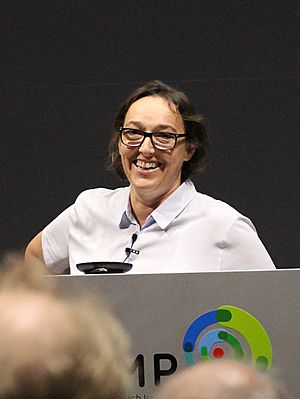Angelika Amon facts for kids
Quick facts for kids
Angelika Amon
|
|
|---|---|

Amon in October 2017.
|
|
| Born | January 10, 1967 Vienna, Austria
|
| Died | October 29, 2020 (aged 53) |
| Citizenship | Austria & United States |
| Alma mater |
|
| Known for | Chromosome duplication and cell division |
| Awards |
|
| Scientific career | |
| Institutions |
|
| Doctoral advisor | Kim Nasmyth |
Angelika Amon (born January 10, 1967 – died October 29, 2020) was an amazing Austrian American scientist. She was a molecular and cell biologist. This means she studied the tiny parts inside cells and how they work.
Angelika Amon was a special professor at the Massachusetts Institute of Technology (MIT). Her main research focused on how chromosomes are controlled and copied when cells divide. Chromosomes are like instruction manuals for our bodies, found inside every cell. In 2017, she was chosen to be part of the American Academy of Arts and Sciences, which is a big honor.
Contents
Early Life and Education
Angelika Amon grew up in Vienna, Austria. From a young age, she loved learning about plants and animals. She even kept a notebook filled with interesting newspaper clippings about biology.
Her interest in science grew when she learned about genetics in middle school. She was also fascinated by time-lapse videos showing plant cells dividing. This made her want to study biology even more.
She earned her first degree in biology from the University of Vienna. Then, she continued her studies there, getting her PhD in 1993. After finishing her studies in Austria, she moved to the United States in 1994. She joined the Whitehead Institute in Cambridge, Massachusetts, to do more research. By 1996, she was able to start her very own lab there.
A Brilliant Career in Science
Angelika Amon's important work at the Whitehead Institute helped her become a professor at MIT in 1999. In the same year, she received the Presidential Early Career Award for Scientists and Engineers. This award is one of the highest honors for young scientists in the United States.
In 2000, she became an investigator for the Howard Hughes Medical Institute. This is a group that supports top scientists. She became a full professor at MIT in 2007.
Angelika Amon was also part of the editorial board for a science magazine called Current Biology. She also served on the Scientific Advisory Board for the Research Institute of Molecular Pathology (IMP) for many years.
In 2017, she was named the Kathleen and Curtis Marble Professor of Cancer Research at MIT. Two years later, she received the Vilcek Prize. This award celebrates foreign-born researchers who have made amazing contributions in their fields in the United States.
Personal Life
Angelika Amon was married to Johannes Weis. They had two daughters named Theresa and Clara.
She passed away on October 29, 2020, at the age of 53. She had been battling ovarian cancer for about two and a half years.
Her Important Research
Angelika Amon's research focused on how cells manage their chromosomes during cell division. Imagine cells as tiny factories. When they divide, they need to make sure each new cell gets a perfect copy of all the instructions (chromosomes). If something goes wrong, it can lead to problems.
As a student, she made key discoveries about how cells control their growth and division. Later, in her own lab, she used yeast (a type of fungus) to study how cells divide. Yeast cells are great for this because they are simple and grow quickly.
Her team found that a protein called CDC20 is very important for cell division. They also discovered how cells know when to finish dividing and return to their normal state.
More recently, Angelika Amon studied how chromosomes are passed on correctly when cells divide to make new cells, like in meiosis.
Her group also studied what happens when cells have too many or too few chromosomes. This condition is called aneuploidy. They found that aneuploidy can cause cells to have problems, like needing more energy or having trouble making proteins. She also showed that this happens in mammal cells, not just yeast.
Angelika Amon's research on aneuploidy is very important for cancer research. She found that having the wrong number of chromosomes can stop a cell's normal repair systems. This can allow bad changes (mutations) to build up, which can lead to cancer.
Awards and Honors
Angelika Amon received many important awards for her scientific work:
- 1998 Presidential Early Career Award for Scientists and Engineers
- 2003 Alan T. Waterman Award
- 2003 Eli Lilly and Company-Elanco Research Award
- 2007 Paul Marks Prize for Cancer Research
- 2008 NAS Award in Molecular Biology
- 2013 Ernst Jung Prize
- 2018 Vanderbilt Prize in Biomedical Science
- 2019 Breakthrough Prize in Life Sciences
- 2019 Vilcek Prize
- 2020 HFSP Nakasone Award
Images for kids
See also
 In Spanish: Angelika Amon para niños
In Spanish: Angelika Amon para niños


